Software Testing Best Practices to Boost QA Quality
Learn important software testing best practices to improve quality, speed up delivery, and reduce costs. Read our expert guide today!
In today's fast-paced software development landscape, simply 'finding bugs' is no longer enough. True quality assurance has evolved into a strategic discipline crucial for business success. Adopting robust software testing best practices is the key to not only shipping higher-quality products but also accelerating delivery cycles and reducing long-term costs. This comprehensive guide moves beyond the basics to provide a roundup of 10 essential practices that modern quality teams must master.
We'll explore actionable strategies, from shifting testing left to integrating performance and security, providing the insights you need to build a world-class testing framework. To truly transform your approach, a deep understanding of core Quality Assurance principles is essential, extending beyond just testing. Mastering these concepts will ensure your team consistently delivers excellence.
As development workflows become more complex, integrating all your tools into a single powerhouse platform like Zemith can significantly streamline these practices. From documenting test cases in a smart notepad to using its coding assistant for writing unit tests, Zemith creates a unified ecosystem for unparalleled productivity. This article details the specific strategies you can implement, with or without such a platform, to elevate your software quality.
1. Test Early and Often (Shift-Left Testing)
One of the most impactful software testing best practices is the principle of shifting left, which means integrating testing activities as early as possible in the development lifecycle. Instead of treating testing as a final phase before release, this approach makes it a continuous and collaborative process, starting from the requirements and design stages. The core idea, popularized by pioneers like Larry Smith, is to prevent defects rather than just finding them late in the game.

When defects are caught early, they are significantly cheaper and faster to fix. This proactive stance not only improves code quality but also accelerates delivery cycles. For example, IBM's adoption of shift-left testing in their mainframe development led to a 30% reduction in testing cycles, showcasing the immense efficiency gains possible.
How to Implement Shift-Left Testing
Integrating this practice requires a cultural and procedural shift across development and QA teams. Here are actionable insights to get started:
- Review requirements and designs: Involve QA in early-stage meetings to identify ambiguities and potential issues before a single line of code is written.
- Automate with the right tools: Implement static code analysis tools directly within the CI/CD pipeline. This provides developers with immediate feedback on code quality and potential vulnerabilities.
- Empower developers: Train developers in fundamental testing techniques and practices like Test-Driven Development (TDD). This fosters a shared sense of responsibility for quality.
- Enhance collaboration: Utilize a platform like Zemith to create a unified workspace. Here, development, QA, and product teams can collaborate on requirements, draft test cases in a shared notepad, and track issues, ensuring clear communication from day one.
2. Test Automation Pyramid
Another foundational software testing best practice is adopting the Test Automation Pyramid, a strategic framework for structuring your automated test suite. Popularized by thought leaders like Mike Cohn and Martin Fowler, this model guides teams to build a balanced and efficient testing portfolio. It emphasizes a strong base of fast, isolated unit tests, a smaller layer of integration tests, and a minimal number of slow, comprehensive end-to-end (E2E) tests at the peak.
This hierarchical approach ensures that the majority of testing is fast, reliable, and provides quick feedback, which is crucial for agile and DevOps environments. For instance, Google's engineering teams famously follow a 70/20/10 split, dedicating 70% of their efforts to unit tests, 20% to integration tests, and only 10% to E2E tests, which maximizes stability and development velocity.
The following diagram visualizes the recommended distribution of tests within the pyramid.
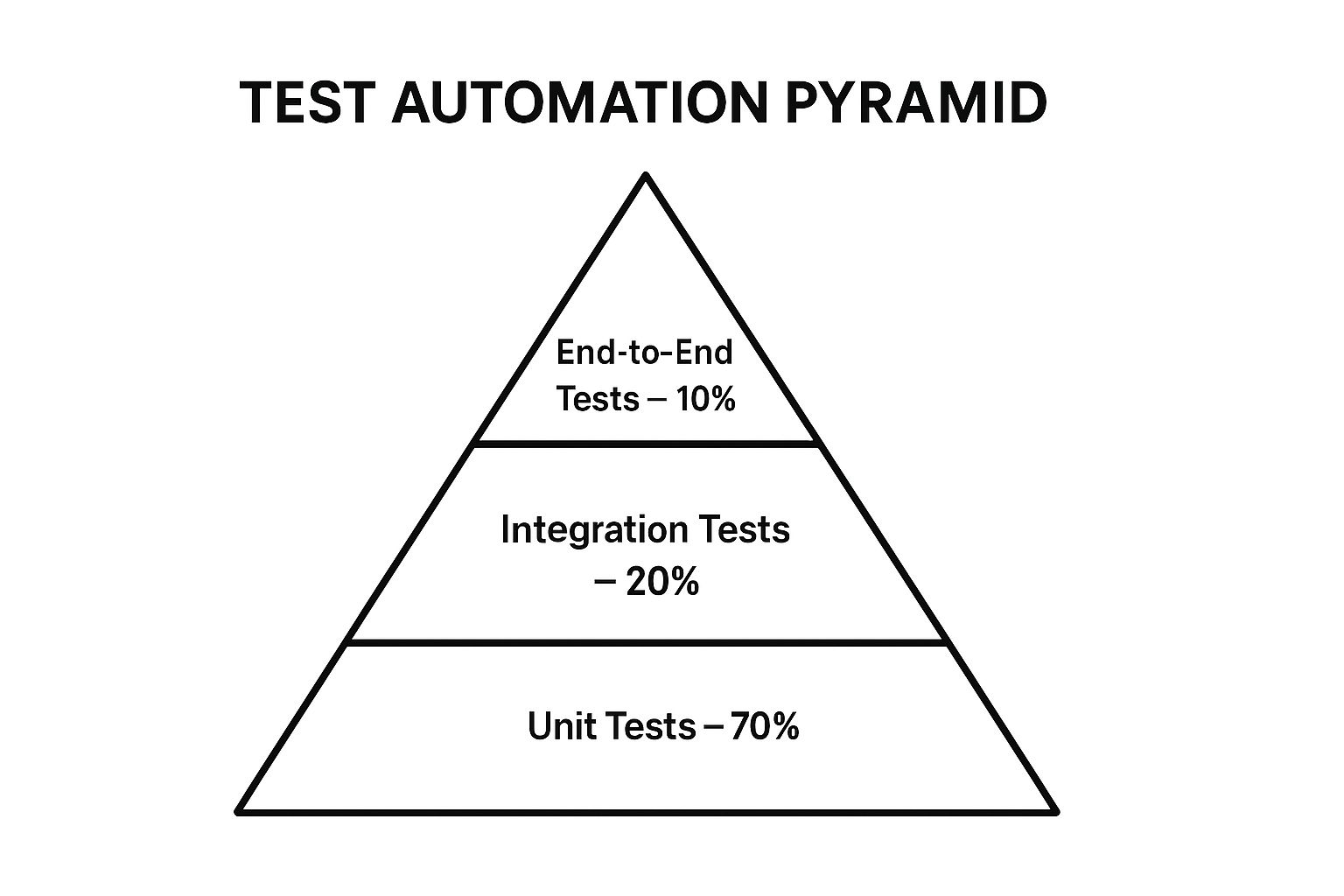
This visual model clearly shows that the bulk of your automation investment should be at the unit level to maintain a healthy and efficient testing process.
How to Implement the Test Automation Pyramid
Building a balanced pyramid requires deliberate planning and the right tools. Here are actionable insights to achieve this:
- Build a strong foundation: Start by ensuring developers write comprehensive unit tests for every new feature. A tool like Zemith's AI coding assistant can accelerate this process by generating unit test skeletons, reducing manual effort.
- Limiting UI tests: Reserve slow and often brittle end-to-end UI tests for validating only the most critical user journeys and business flows.
- Using contract testing: For microservices or API-driven architectures, implement contract testing to verify interactions between services without needing full end-to-end environments.
- Centralizing test management: Use a platform like Zemith to manage and track tests from all layers of the pyramid. This provides a unified view of your test coverage, from unit tests to E2E scenarios, helping you maintain the right balance and ensure comprehensive quality oversight.
3. Risk-Based Testing
Not all features are created equal, and Risk-Based Testing (RBT) is a strategic approach that acknowledges this reality. This software testing best practice prioritizes testing efforts based on the potential business and technical risks associated with different parts of an application. Rather than trying to test everything with the same intensity, RBT, championed by experts like Dorothy Graham and the ISTQB, focuses resources on the most critical and high-risk components to maximize effectiveness and mitigate potential failures where they matter most.
For example, a banking application would prioritize testing transaction processing and security functions over its "About Us" page. Similarly, an e-commerce platform would concentrate efforts on the payment gateway and checkout process, as failures in these areas have the most severe financial and reputational consequences. This targeted approach ensures that the most significant threats to project success are addressed first.
How to Implement Risk-Based Testing
Adopting RBT requires a collaborative analysis of what could go wrong and how much it would matter. Here are actionable insights to integrate this practice:
- Involve business stakeholders: Collaborate with product owners and business analysts to identify features with the highest business impact. Their insights are crucial for understanding which failures would be most damaging.
- Analyzing historical data: Use past defect reports and production incident logs to identify recurring problem areas. This data provides an evidence-based foundation for your risk assessment.
- Combining risk perspectives: Evaluate risk from both a technical standpoint (complexity, new technology) and a business standpoint (revenue impact, user visibility, compliance).
- Using a centralized platform: Employ a tool like Zemith to document and track risk assessments. By linking risks directly to requirements and test cases in a shared workspace, your team can ensure prioritization decisions are transparent, data-driven, and consistently applied throughout the testing process.
4. Continuous Testing in CI/CD
Building upon the shift-left philosophy, another of the most critical software testing best practices is integrating continuous testing directly into the CI/CD pipeline. This practice, advocated by thought leaders like Jez Humble and Dave Farley, involves executing automated tests at every stage of the software delivery process. The goal is to get immediate feedback on the business risks associated with a new build or release candidate, making testing an ongoing activity rather than a separate phase.

This approach enables organizations to release software faster and with greater confidence. For instance, Amazon executes thousands of deployments daily, a feat made possible by automated testing gates within its sophisticated CI/CD pipeline that validate changes without manual intervention. This constant validation is the bedrock of modern DevOps and rapid, high-quality delivery.
How to Implement Continuous Testing
Successfully embedding testing into your pipeline requires strategic planning and the right tooling. Here are actionable insights to get started:
- Start small and expand: Begin by integrating a foundational suite of smoke tests that run with every code commit. Gradually expand coverage to include regression, performance, and security tests at appropriate stages.
- Use parallel test execution: Reduce pipeline feedback time by running tests in parallel. This significantly cuts down the waiting period for developers and accelerates the entire delivery cycle.
- Establish clear quality gates: Define specific pass/fail criteria for each testing stage in the pipeline. A failed test should automatically prevent a build from progressing, ensuring only quality code moves forward.
- Centralize test management: Utilize a platform like Zemith to integrate your CI/CD tools and centralize test results. This provides a unified dashboard for monitoring pipeline health, analyzing test failures, and ensuring all stakeholders have visibility into quality metrics in one place.
5. Test-Driven Development (TDD)
Test-Driven Development (TDD) flips the traditional development script by requiring tests to be written before the code they are meant to validate. This disciplined approach is one of the cornerstone software testing best practices that embeds quality directly into the development process. Popularized by Kent Beck, TDD follows a simple but powerful cycle: Red-Green-Refactor. First, you write a failing test (Red), then you write the minimum code necessary to make it pass (Green), and finally, you clean up the code without changing its behavior (Refactor).
This methodology ensures that every piece of code is covered by a test from its inception, leading to a highly reliable and maintainable codebase. For instance, the legendary Chrysler C3 project, guided by Kent Beck, successfully used TDD to manage complexity and deliver a working system. Similarly, Spotify’s engineering teams often apply TDD principles to build robust new features, ensuring stability as their platform rapidly evolves.
How to Implement Test-Driven Development
Adopting TDD is a mindset shift that promotes thinking about requirements before implementation. Here are actionable insights to get started:
- Start with simple cases: Begin by writing tests for the most basic, straightforward behavior of a function or module. Gradually build up to more complex scenarios.
- Focus on behavior, not implementation: Your tests should verify what the code does, not how it does it. This makes your tests less brittle and easier to maintain when you refactor.
- Keep tests independent: Each test should be able to run in isolation without depending on others. This prevents cascading failures and makes it easier to pinpoint the exact source of a bug.
- Centralize test case development: To ensure TDD is effective across teams, use a platform like Zemith. Its collaborative notepad allows developers and QA to draft test cases directly from user stories. The integrated AI coding assistant can then use these specifications to generate the initial failing test (Red), kickstarting the TDD cycle efficiently.
6. Comprehensive Test Documentation
Maintaining clear and thorough documentation is a foundational software testing best practice that ensures clarity, traceability, and knowledge continuity across projects. Comprehensive test documentation involves creating detailed records of test plans, cases, execution results, and defects. This practice, formalized by standards like IEEE 829 and championed by bodies like ISTQB, turns testing from an isolated activity into a transparent and auditable process.
In regulated industries like finance or medical devices, detailed documentation isn't just a best practice; it's a mandatory requirement for compliance. For example, FDA-regulated medical device manufacturers must provide exhaustive test evidence to prove safety and efficacy. This level of detail prevents ambiguity, facilitates smooth onboarding for new team members, and provides a reliable record for future maintenance and regression testing cycles.
How to Implement Comprehensive Test Documentation
Effective documentation balances detail with agility. Here are actionable insights for achieving this:
- Using standardized templates: Create and enforce consistent templates for test plans, test cases, and bug reports. This ensures all necessary information is captured uniformly across the team.
- Balancing detail with project needs: Tailor the level of documentation to your project’s complexity and regulatory requirements. Not every project needs the same exhaustive level of detail.
- Leveraging collaborative tools: Utilize platforms like Zemith to create a centralized, living documentation system. Its smart notepad allows you to link test cases directly to requirements and defects, ensuring that documentation is always up-to-date and easily accessible to all stakeholders.
- Applying clear writing principles: Your documentation is only as good as it is understandable. Applying strong principles, such as those found in comprehensive guides on technical writing best practices, ensures your test cases and reports are clear, concise, and actionable for everyone.
7. Environment Management and Test Data Strategy
A robust approach to software testing best practices must include a solid strategy for test environments and data. This involves creating and maintaining reliable test environments that accurately mirror production, alongside a plan for generating realistic, secure, and comprehensive test data. The core idea, driven by DevOps and SRE communities, is that testing is only as reliable as the environment and data it uses.
Inconsistent environments lead to flaky tests and "it works on my machine" scenarios, while poor data results in missed bugs and security risks. For instance, Netflix effectively tests its complex microservices architecture using isolated, containerized environments for each service, ensuring that tests are both reliable and independent. This prevents environmental cross-contamination and provides consistent results.
How to Implement Environment and Data Management
Effective management requires a combination of automation, process, and the right tools. Here are actionable insights:
- Using Infrastructure-as-Code (IaC): Utilize tools like Terraform or CloudFormation to define and provision test environments through code. This ensures every environment is identical, repeatable, and easily disposable.
- Automating environment provisioning: Integrate IaC scripts into your CI/CD pipeline to automatically spin up fresh environments for each test run and tear them down afterward, optimizing resource usage.
- Implementing a clear data strategy: Use data masking and synthetic data generation tools to create realistic datasets that comply with privacy regulations like GDPR. Establish clear procedures for data refresh and cleanup.
- Centralizing management and collaboration: Use a platform like Zemith to link test cases directly to specific environment configurations and test data sets. This provides a single source of truth, ensuring testers know exactly which environment and data to use for any given scenario, drastically reducing confusion and errors.
8. Defect Prevention and Root Cause Analysis
While finding bugs is a core function of testing, one of the most advanced software testing best practices is to prevent them from ever occurring. This proactive approach, known as defect prevention, shifts the focus from fixing individual bugs to eliminating their underlying causes. Inspired by quality management pioneers like W. Edwards Deming, this practice involves a systematic root cause analysis (RCA) to understand why defects happen and implement changes to stop them from recurring.
Adopting this mindset transforms quality assurance from a reactive to a strategic function. For instance, Toyota's legendary production system is built on principles of stopping the line to fix problems at their source, a philosophy that directly translates to software development. By analyzing defect trends, teams can identify systemic weaknesses in processes, tools, or training, leading to significant long-term improvements in both quality and velocity.
How to Implement Defect Prevention and RCA
Moving from defect detection to prevention requires a disciplined, data-driven approach. Here are actionable insights to get started:
- Establish a Formal RCA Process: When a critical or recurring bug is found, don't just fix it. Convene a cross-functional team (developers, QA, product) to conduct a "5 Whys" analysis or use a fishbone diagram to trace the issue back to its true origin.
- Analyze Defect Data: Use your bug tracking system to identify patterns. Are most defects related to a specific module, a certain type of requirement, or a particular developer? This analysis highlights where to focus your prevention efforts.
- Improve Upstream Processes: Often, the root cause is not in the code but in ambiguous requirements. Use a collaborative platform like Zemith to ensure requirements are clearly defined and reviewed by all stakeholders before development begins, preventing a major source of defects.
- Refine Your Feedback Loop: To streamline the identification and resolution of issues, understanding the essential bug reporting best practices is crucial for providing developers with the clear, concise information needed for effective RCA.
9. Cross-functional Team Collaboration
One of the most transformative software testing best practices is embedding quality within a culture of cross-functional team collaboration. This approach dismantles traditional silos between development, testing, operations, and business units, fostering a shared responsibility for quality. Instead of a linear hand-off, teams work together continuously, ensuring quality is a collective goal from the start, a principle championed by the Agile Manifesto and the DevOps movement.

When teams collaborate effectively, communication flows freely, leading to faster problem-solving and a deeper understanding of user needs across all roles. For example, Spotify’s renowned "Squad" model embeds quality advocates directly within development teams, enabling immediate feedback and proactive quality improvements. This collaborative synergy not only accelerates delivery but also builds higher-quality, more user-centric products.
How to Implement Cross-functional Collaboration
Fostering a truly collaborative environment requires deliberate effort. Here are actionable insights to get started:
- Defining shared quality goals: Establish clear, measurable quality metrics that the entire team, from developers to product owners, is responsible for achieving.
- Implementing pair testing: Have a developer and a tester work together on the same feature simultaneously. This practice helps catch defects earlier and promotes knowledge sharing between roles.
- Establishing clear communication channels: Use regular stand-ups, retrospectives, and dedicated channels to ensure information flows seamlessly between all team members.
- Utilizing collaborative platforms: Tools like Zemith are essential for creating a unified workspace. They centralize communication, documentation, and task management, allowing cross-functional teams to track progress, share feedback, and resolve issues efficiently in one place.
10. Performance and Security Testing Integration
Integrating performance and security testing into the development lifecycle is a critical software testing best practice that prevents costly post-release disasters. Instead of treating these as separate, final-gate activities, this approach, often called DevSecOps, embeds them directly into the continuous integration and delivery pipeline. The core principle, championed by organizations like OWASP and the Site Reliability Engineering community, is to build secure and performant applications from the ground up.
This proactive integration ensures non-functional requirements are met consistently, safeguarding user experience and protecting sensitive data. For example, Netflix’s famed chaos engineering practices continuously test system resilience, while Dropbox integrates robust security scanning directly into its CI/CD pipeline. These companies treat performance and security as features, not chores, preventing bottlenecks and vulnerabilities before they ever reach production.
How to Implement Performance and Security Testing Integration
Shifting these practices left requires automated tools and a collaborative mindset. Here are actionable insights to get started:
- Establish clear baselines: Define and document acceptable performance metrics (e.g., response time under load) and security standards (e.g., OWASP Top 10) early in the project.
- Automate in the CI/CD pipeline: Integrate static (SAST) and dynamic (DAST) security scanning tools, as well as load testing scripts, to run automatically with every build.
- Use production-like environments: Conduct performance tests in staging environments that closely mirror production infrastructure to get realistic and reliable results.
- Unify efforts with a central hub: Use platforms like Zemith to manage and track performance benchmarks and security test results alongside functional test cases. This creates a single source of truth, enabling teams to correlate performance dips or security flags with specific code changes for faster resolution.
Best Practices Comparison Matrix
| Approach | Implementation Complexity 🔄 | Resource Requirements ⚡ | Expected Outcomes 📊 | Ideal Use Cases 💡 | Key Advantages ⭐ |
|---|---|---|---|---|---|
| Test Early and Often (Shift-Left Testing) | Medium to high; requires cultural/process change | Skilled testers, early involvement | Reduced defect cost, improved quality, faster delivery | Projects aiming for early defect detection and prevention | Early bug detection, cost-saving, better alignment |
| Test Automation Pyramid | Medium; requires test infrastructure and balance | Investment in unit and integration tests | Fast feedback, reliable tests, cost-effective maintenance | Applications with layered testing needs and modular architecture | Optimal speed, reliability, and maintainability |
| Risk-Based Testing | High; needs upfront risk analysis and planning | Domain experts, stakeholder involvement | Focused testing on critical areas, optimized ROI | Regulated and mission-critical systems | Maximizes ROI, focused resource allocation |
| Continuous Testing in CI/CD | High; setup and environment management needed | Robust automation and CI/CD tools | Rapid feedback, reduced manual effort, improved pipeline visibility | Fast-paced environments with frequent deployments | Fast feedback, automated, reduces errors |
| Test-Driven Development (TDD) | High; requires developer discipline and training | Developer time and testing skills | High test coverage, better code design, reduced defects | Agile teams focused on high-quality code and refactoring | Code quality, living documentation, defect reduction |
| Comprehensive Test Documentation | Medium; detailed and ongoing documentation effort | Documentation tools and process dedication | Compliance, traceability, knowledge transfer | Regulated industries and quality-critical projects | Compliance, audit readiness, clear guidance |
| Environment Management and Test Data Strategy | High; infrastructure and data compliance challenges | Infrastructure, specialized tools and skills | Consistent environments, reliable tests, data privacy | Large-scale, regulated projects requiring realistic testing | Reliable tests, parallel execution, compliance |
| Defect Prevention and Root Cause Analysis | Medium; requires analytical and process improvement skills | Skilled analysts and continuous monitoring | Lower defect density, improved processes, customer satisfaction | Organizations focusing on quality and process maturity | Long-term quality improvement and cost reduction |
| Cross-functional Team Collaboration | Medium to high; cultural and coordination effort | Collaboration tools and management support | Improved quality, faster issue resolution, aligned goals | Agile and DevOps teams requiring shared quality ownership | Enhanced communication, team efficiency, learning |
| Performance and Security Testing Integration | High; specialized skills and infrastructure | Performance/security tools and expertise | Early issue detection, compliance, improved user trust | Security-sensitive and performance-critical applications | Early risk mitigation, compliance, user experience |
Building Your Future-Proof QA Strategy
The journey through the landscape of modern software development reveals a fundamental truth: quality is not an afterthought, but a foundational pillar built through deliberate, consistent effort. The software testing best practices we've explored, from shifting left to continuous integration, are more than just a checklist. They represent a cultural shift, transforming testing from a final, often-rushed gatekeeper into an integrated, value-driving discipline that permeates every stage of the development lifecycle.
Adopting these principles is a strategic move away from reactive defect detection and toward proactive quality assurance. Instead of simply finding bugs before a release, your team becomes an agent of prevention. By implementing a robust Test Automation Pyramid, you create a stable, efficient feedback loop. By integrating performance and security testing early, you fortify your application against critical vulnerabilities from the start. This proactive stance is the core of a future-proof QA strategy.
From Theory to Tangible Results
Making these software testing best practices a reality requires more than just understanding the concepts; it demands a structured approach and the right supportive environment. Here are the most impactful, actionable takeaways for your team:
- Integration Over Isolation: The most significant gains come from breaking down silos. Integrating testing into the CI/CD pipeline, fostering cross-functional collaboration, and applying TDD principles ensure that quality is a shared responsibility, not just the QA team's burden.
- Strategy Over Brute Force: Smart testing trumps more testing. A risk-based approach allows you to focus your limited resources on the areas of the application that pose the greatest risk to the business, maximizing impact and efficiency.
- Documentation as a Blueprint: Comprehensive test documentation and a clear data management strategy are not bureaucratic hurdles. They are essential blueprints that enable consistency, scalability, and effective knowledge transfer, especially as teams and projects grow.
Your Actionable Next Steps
Embarking on this journey can feel daunting, but progress is achieved through iterative steps, not a single leap. Begin by identifying one or two practices that address your team's most pressing pain points. Perhaps that's formalizing your test data strategy to reduce environment-related bugs or introducing root cause analysis sessions to prevent recurring defects.
To truly accelerate this transformation, consider how a unified workspace can eliminate friction and centralize your efforts. Many of the challenges in implementing these practices, like fragmented documentation and disjointed communication, stem from using too many disconnected tools. A platform that brings planning, scripting, and collaboration into one place can be a powerful catalyst for change. For instance, using an AI-powered workspace like Zemith allows teams to collaboratively draft test cases in a shared notepad, use a coding assistant to rapidly generate automation scripts, and keep all artifacts organized and accessible. This consolidation is a critical step in operationalizing the very software testing best practices discussed, enabling your team to focus on delivering exceptional quality.
Ready to unify your testing workflow and empower your team? Discover how Zemith’s all-in-one AI workspace can help you implement these software testing best practices by centralizing your test planning, scripting, and documentation. Start building your future-proof QA strategy with Zemith today.
Article created using Outrank
Explore Zemith Features
Introducing Zemith
The best tools in one place, so you can quickly leverage the best tools for your needs.
All in One AI Platform
Go beyond AI Chat, with Search, Notes, Image Generation, and more.
Cost Savings
Access latest AI models and tools at a fraction of the cost.
Get Sh*t Done
Speed up your work with productivity, work and creative assistants.
Constant Updates
Receive constant updates with new features and improvements to enhance your experience.
Features
Selection of Leading AI Models
Access multiple advanced AI models in one place - featuring Gemini-2.5 Pro, Claude 4.5 Sonnet, GPT 5, and more to tackle any tasks

Speed run your documents
Upload documents to your Zemith library and transform them with AI-powered chat, podcast generation, summaries, and more
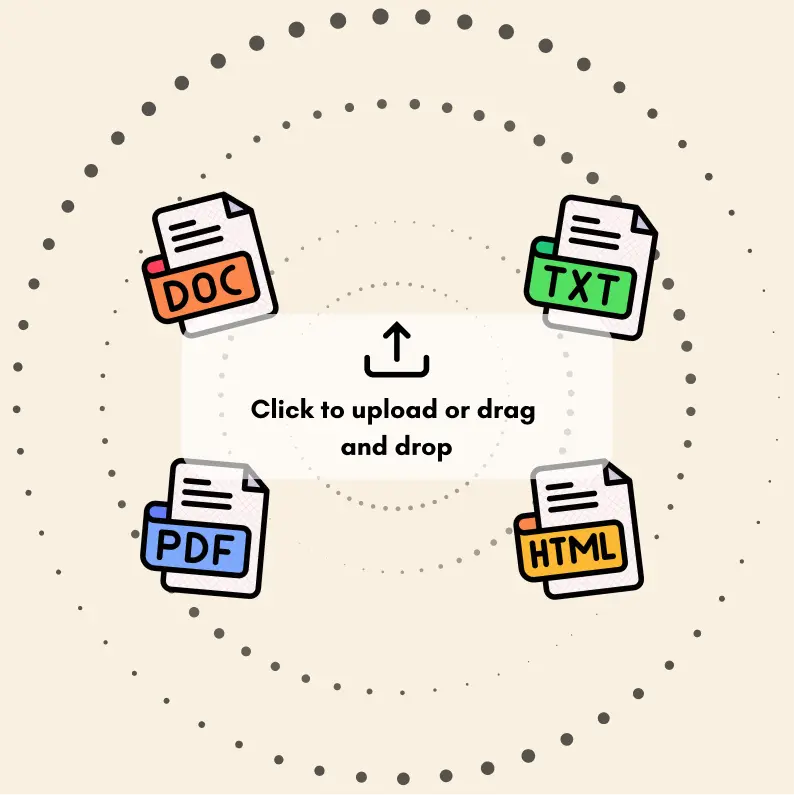
Transform Your Writing Process
Elevate your notes and documents with AI-powered assistance that helps you write faster, better, and with less effort
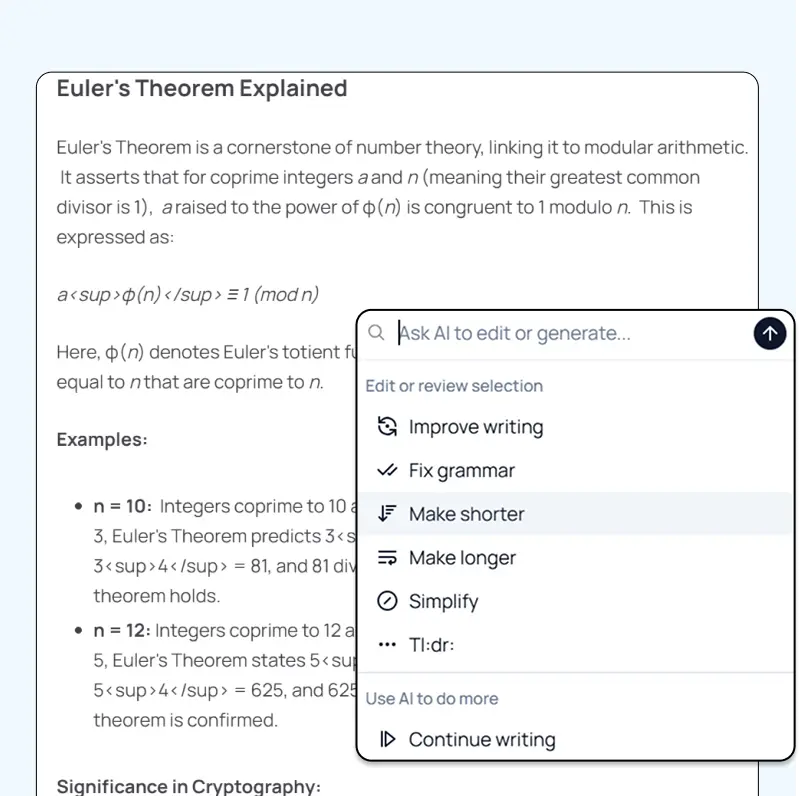
Unleash Your Visual Creativity
Transform ideas into stunning visuals with powerful AI image generation and editing tools that bring your creative vision to life

Accelerate Your Development Workflow
Boost productivity with an AI coding companion that helps you write, debug, and optimize code across multiple programming languages
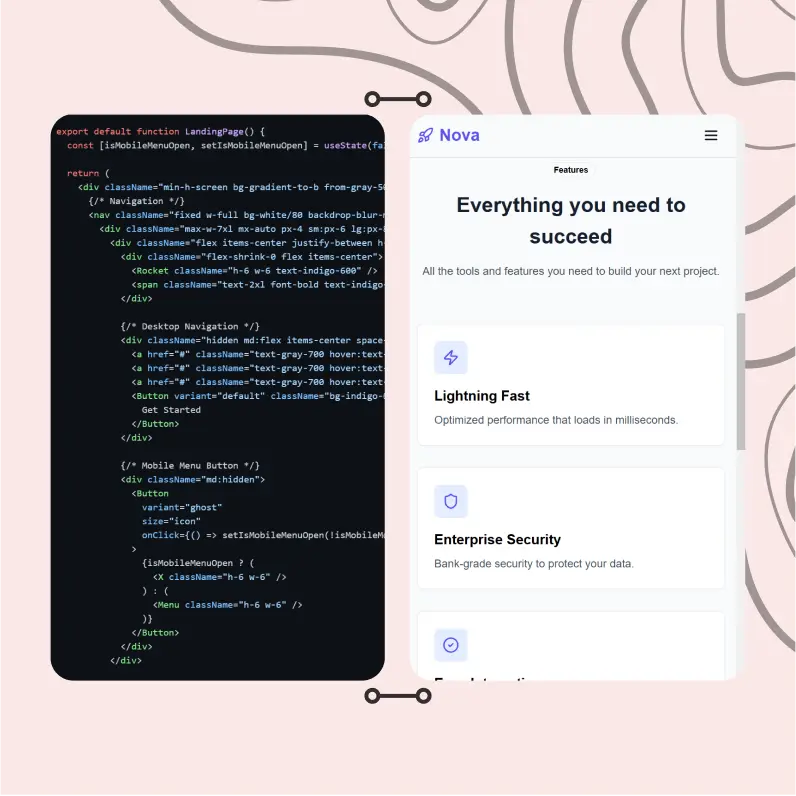
Powerful Tools for Everyday Excellence
Streamline your workflow with our collection of specialized AI tools designed to solve common challenges and boost your productivity
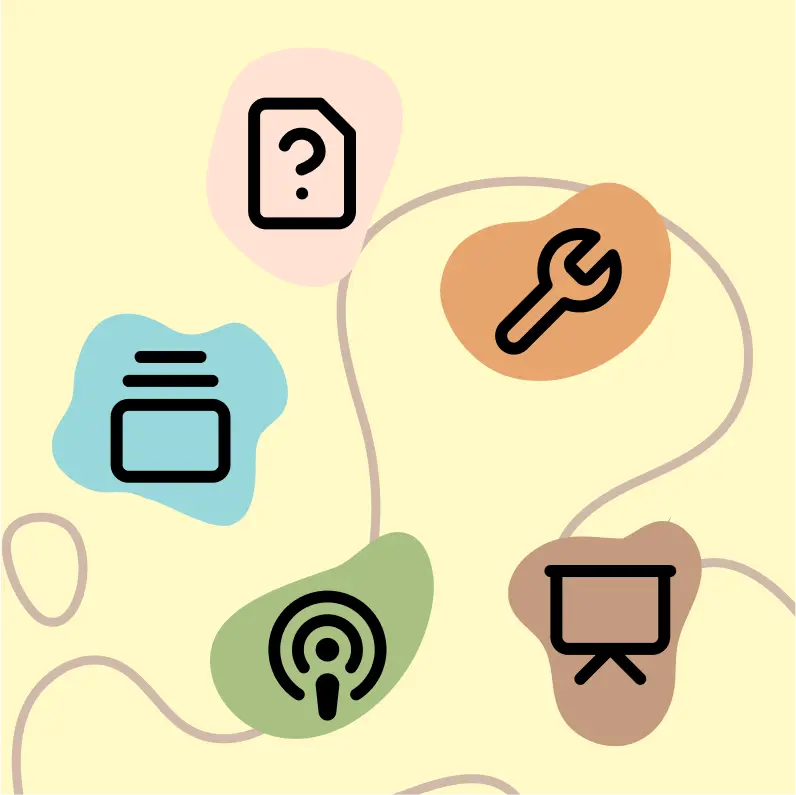
Live Mode for Real Time Conversations
Speak naturally, share your screen and chat in realtime with AI
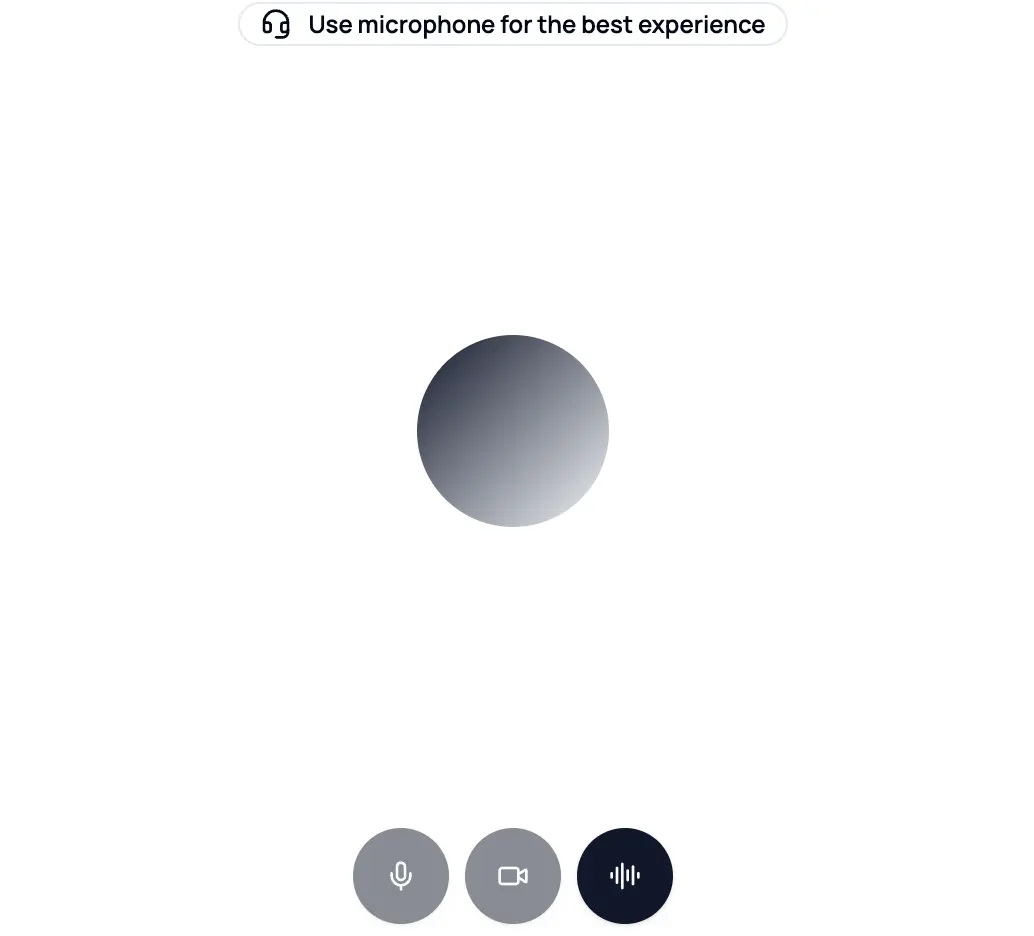
AI in your pocket
Experience the full power of Zemith AI platform wherever you go. Chat with AI, generate content, and boost your productivity from your mobile device.

Deeply Integrated with Top AI Models
Beyond basic AI chat - deeply integrated tools and productivity-focused OS for maximum efficiency
Straightforward, affordable pricing
Save hours of work and research
Affordable plan for power users
Plus
- 10000 Credits Monthly
- Access to plus features
- Access to Plus Models
- Access to tools such as web search, canvas usage, deep research tool
- Access to Creative Features
- Access to Documents Library Features
- Upload up to 50 sources per library folder
- Access to Custom System Prompt
- Access to FocusOS up to 15 tabs
- Unlimited model usage for Gemini 2.5 Flash Lite
- Set Default Model
- Access to Max Mode
- Access to Document to Podcast
- Access to Document to Quiz Generator
- Access to on demand credits
- Access to latest features
Professional
- Everything in Plus, and:
- 21000 Credits Monthly
- Access to Pro Models
- Access to Pro Features
- Access to Video Generation
- Unlimited model usage for GPT 5 Mini
- Access to code interpreter agent
- Access to auto tools
- 10000 Credits Monthly
- Access to plus features
- Access to Plus Models
- Access to tools such as web search, canvas usage, deep research tool
- Access to Creative Features
- Access to Documents Library Features
- Upload up to 50 sources per library folder
- Access to Custom System Prompt
- Access to FocusOS up to 15 tabs
- Unlimited model usage for Gemini 2.5 Flash Lite
- Set Default Model
- Access to Max Mode
- Access to Document to Podcast
- Access to Document to Quiz Generator
- Access to on demand credits
- Access to latest features
- Everything in Plus, and:
- 21000 Credits Monthly
- Access to Pro Models
- Access to Pro Features
- Access to Video Generation
- Unlimited model usage for GPT 5 Mini
- Access to code interpreter agent
- Access to auto tools
What Our Users Say
Great Tool after 2 months usage
simplyzubair
I love the way multiple tools they integrated in one platform. So far it is going in right dorection adding more tools.
Best in Kind!
barefootmedicine
This is another game-change. have used software that kind of offers similar features, but the quality of the data I'm getting back and the sheer speed of the responses is outstanding. I use this app ...
simply awesome
MarianZ
I just tried it - didnt wanna stay with it, because there is so much like that out there. But it convinced me, because: - the discord-channel is very response and fast - the number of models are quite...
A Surprisingly Comprehensive and Engaging Experience
bruno.battocletti
Zemith is not just another app; it's a surprisingly comprehensive platform that feels like a toolbox filled with unexpected delights. From the moment you launch it, you're greeted with a clean and int...
Great for Document Analysis
yerch82
Just works. Simple to use and great for working with documents and make summaries. Money well spend in my opinion.
Great AI site with lots of features and accessible llm's
sumore
what I find most useful in this site is the organization of the features. it's better that all the other site I have so far and even better than chatgpt themselves.
Excellent Tool
AlphaLeaf
Zemith claims to be an all-in-one platform, and after using it, I can confirm that it lives up to that claim. It not only has all the necessary functions, but the UI is also well-designed and very eas...
A well-rounded platform with solid LLMs, extra functionality
SlothMachine
Hey team Zemith! First off: I don't often write these reviews. I should do better, especially with tools that really put their heart and soul into their platform.
This is the best tool I've ever used. Updates are made almost daily, and the feedback process is very fast.
reu0691
This is the best AI tool I've used so far. Updates are made almost daily, and the feedback process is incredibly fast. Just looking at the changelogs, you can see how consistently the developers have ...
